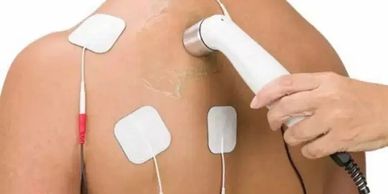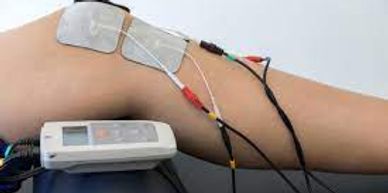(916) 365-2559 personalized sports & family chiro
PHYSIOTHERAPY & REHABILITATION
electric stimulation therapy

EMS with high voltage can be implemented by chiropractors to support wound healing.
EMS devices are used to “jumpstart” muscle contractions otherwise known as neuromuscular re-education.
This type of electrical stimulation can also deliver medication through the skin. It is used to decrease inflammation, decrease swelling in a particular area, manage the development of scar tissue, and relax spasming muscles.
Electric muscle stimulation (E-stim) is a treatment option or rehabilitation from an injury. One of the benefits of electric muscle stimulation is speeding up the body’s natural recovery process. Other E-stim benefits are relieving pain in the body, reducing swelling, and promoting general muscle tone.
Electrical stimulation works by providing electrical impulses to nerve endings in an area of injury. The stimulation soothes the nerve endings, provides pain relief, and may also increase blood flow to speed up healing in injured tissues.
You may not realize it, but many high-level athletes use electrical muscle stimulation after vigorous physical activity. Using electrical muscle stimulation after workouts helps reduce swelling and minimizes soreness, factors that affect performance. In addition, athletes who use electrical muscle stimulation in their chiropractic care between activities often have less muscle stiffness. The low levels of electric currents help keep muscles warm when they aren’t in use during physical activity.
Here's how the E-stim works
Typically, the body’s central nervous system will transmit information, such as the message to contract a specific muscle, throughout the body via its internal electric impulses. The electric impulses created by an E-stim device simulate what naturally happens in the body when a muscle voluntarily contracts and releases.
Electrical stimulation treatments involve the use of pads connected to an electrical stimulation device. Your chiropractor will attach these pads, called electrodes, to the skin above the affected soft tissue. Through the E-stim device, the electrodes deliver specific, brief electric impulses. These impulses can vary in intensity, depending on the device’s setting, the area being treated, and the patient’s preference.
This repetitive contracting and relaxing motion strengthens and helps repair soft tissue, particularly muscles that are weakened, shortened, or injured. The electrical impulses are also believed to block the activity of pain receptors responsible for sending pain messages from the injury site to the brain.
The electrical impulses are also believed to block the activity of pain receptors responsible for sending pain messages from the injury site to the brain.
Electrical Muscle Stimulation (EMS) machines are designed to stimulate the muscles for the purposes of strengthening and rehabilitating them.
tens therapy

Transcutaneous electrical nerve stimulation (TENS) is a noninvasive pain-relief technique. It requires using a small handheld or tabletop device, known as a TENS unit, which is connected via thin wires to adhesive pads.
The adhesive pads, known as electrodes, are placed directly against your skin. When the unit is turned on, the electrodes transmit low-voltage electrical signals to your body.
The frequency and intensity of these signals can be adjusted as necessary. These signals interfere with pain regulation.
A single treatment typically lasts 15 to 20 minutes. It’s not painful, but you might feel a slight tingling or warming sensation where the electrodes meet your skin.
It is important to note that TENS is not curative. This means that it will temporarily ease pain while being used. However, it will not be used to heal injuries
TENS machines may relieve pain caused by many conditions, including:
- arthritis
- fibromyalgia
- headaches and migraines
- labor pain
- menstrual pain
- nerve pain
- sports injuries
- surgery
- wounds and incisions
What's the difference between a TENS unit and an EMS unit?
It's also important to understand that these units don't function the same way.
TENS uses electrical currents to confuse pain signals which in essence diverts pain from being "felt". This is a pain relieving function.
EMS sends an electrical signal to your muscles to cause a contraction for the purpose of exercising and building muscles. It's the same electric signal your brain would send to your muscles to make them contract.
At our office, we have a combination EMS and TENS unit to help with pain releif and to build muscles therapeutically to prevent pain in the future.
trigger point therapy
interferential therapy

Trigger point therapy uses therapeutic massage techniques to locate and alleviate pain caused by trigger points located throughout the body.
What are trigger points?
Essentially, they’re small, localized muscle cramps, usually confined to only one or two of the small fibers that comprise a muscle. These palpable knots respond excessively to even small amounts of stimuli and are a common source of chronic discomfort. The hypersensitivity of these nodules can also cause the discomfort to radiate outward, causing (or “triggering”) pain, tenderness, tingling, and even numbness in other areas of the body. This pain, relayed through the brain and spinal cord, appears in predictable patterns. For example, a trigger point in the peroneus muscle–a muscle on the outside of the lower leg that makes the foot move down and outward–will cause pain in the ankle and not in the side of the leg, where the muscle is actually located.
What causes trigger points?
Trigger points are commonly caused by the muscle fatigue and irritation created by the repetitive motions of our daily lives. Other causes can range from direct trauma to the affected area, skeletal asymmetry (such as a shorter leg or a pelvic imbalance), deficiencies in vitamin B6, magnesium, vitamin C, or folic acid, infections, and even allergies.
Initially, trigger points are treated with direct pressure that is applied for about 10 to 30 seconds, by fingers, knuckles, elbows and sometimes even pinching the muscle. The amount and duration of pressure varies, depending on how sensitive the trigger points are and the client’s response to the stimuli. This pressure forces the blood and oxygen from the tissue. When the pressure is released, the body responds by forcing blood black into the affected area, thus increasing circulation and re-oxygenating the tissue.
This procedure is repeated–depending on the client’s comfort level–until the active trigger point relaxes to a latent state. Reconditioning the muscle with massage strokes after the pain is reduced makes latent trigger points less prone to reactivate.
Since everyone on our team is well versed in trigger point technique, you need only to inquire with your Chiro2me Chiropractor about whether it may benefit you.
interferential therapy
interferential therapy

Interferential (IF) therapy targets the nerves but is more intended for deep chronic pain where TENS is not effective. IF stimulates muscles in a wide variety of protocols and helps relieve deep tissue pain through penetration that can be adjusted to stimulate nerve fibers for increased blood flow. Common uses are pre- and post-orthopedic surgery, joint injury syndrome, cumulative trauma disorders, increasing blood circulation and pain control.
This type of stimulation releases endorphins to promote recovery while increasing blood circulation to the area to support the body's natural healing process. It helps decrease swelling and inflammation and reduce or eliminate pain.
What is Interferential Current Therapy?
Interferential current therapy (ICT, or sometimes IFC) is the most common type of electrical muscle stimulation used to treat chronic pain resulting from surgery, injury or trauma. The end goal for using ICT as part of a physical therapy or rehab program is to relieve pain and help patients heal faster.
This non-invasive, drug-free therapy has minimal side effects. By utilizing higher frequency energy than other forms of EMS, ICT goes past the surface of the skin. It penetrates deep into the body to target the source of pain, without causing discomfort.
Conditions Treated with ICT
ICT is often used to treat muscle strains, spasms, sports injuries, joint damage, and edema. This therapy can provide relief from and chronic pain caused by arthritis, surgery, muscle damage, or an injury, and from symptoms like inflammation and swelling. IFC is often used in combination with chiropractic care and physiotherapy as part of a comprehensive treatment plan for these conditions.
Treatment targets areas of the body to help alleviate soreness, promote healing and a quick recovery. Stimulation can be delivered deep into the tissue in localized areas including:
- Neck
- Back
- Shoulder
- Elbow
- Hip
- Knee
- Wrist
- Feet
- Lower Extremities
In some cases, interferential current therapy is incorporated as part of a patient’s pain management program.
The Advantages of Interferential Current Therapy
This type of stimulation releases endorphins to promote recovery while increasing blood circulation to the area to support the body’s natural healing process. ICT helps decrease swelling and inflammation and reduce or eliminate pain. It can also increase joint mobility and range of motion.
What Patients Should Expect with ICT
Though it may sound like a complicated or uncomfortable treatment, ICT is safe and painless. In fact, most patients say that they feel less discomfort and side effects with ICT than with other types of electrical stimulation. Most describe the experience as a tingling or ‘pins and needles’ sensation on the skin.
Interferential current therapy usually requires sessions with a duration of about 9 to 15 minutes. During this time, the physiotherapist will attach four electrode pads to the area which will be treated. Wires connect the pads to the current intensity regulator device which delivers the frequencies required.
lymphatic drainage
Manual Lymphatic Drainage Massage is a type of massage intended to stimulate the lymphatic system by releasing blockages and assisting the natural circulation required for the elimination of metabolic waste, excess fluids, and bacteria from the body.
To better understand the importance of this treatment, consider how vital your lymphatic system is to your overall health. As part of the circulatory system, your lymphatic system consists of a complex network of organs, nodes, ducts, and vessels. The vessels carry lymph fluid toward the heart and play a key role in your immune system.
If your lymph system is slow or obstructed, it impacts how you feel throughout the day. Our therapy consists of gentle, rhythmic, circular movements, and activates the muscle cells in the walls of the lymph vessels and the surrounding skeletal muscles necessary to propel the lymph through the system. Soon after your massage, you likely “perk up” and your sense of physical and emotional well-being improves.
If you’ve been sick, your recovery time can decrease dramatically after a lymphatic drainage massage.
If you’re feeling tired and low on energy, or if you’ve been sick and feeling like your body is fighting to get back on track, lymph massage would likely serve you well. In addition, athletes, surgical patients, fibromyalgia, and chronic fatigue sufferers may want to consider lymphatic massage. Lymphatic drainage massage has implications for our clients who suffer from serious illnesses, not only those with a general low-energy feeling.
Often, if we’re feeling “run down,” we wait for it to pass, or try to get extra sleep. But sometimes the better, faster, and more effective solution is lymphatic drainage massage. Energy drinks are an easy go-to for some people who are suffering from fatigue, but the results don’t last long and can negatively impact your health.
Contact our Chiro2me doctors today to schedule your lymphatic drainage massage.
myofascial release
What is Myofascial Release and what are the benefits?
Myofascial release is a manual massaging technique that aims to stretch the fascia to treat myofascial pain syndrome, a chronic pain disorder caused by tightness and sensitivity in your myofascial tissues. Injuries, stress, trauma, overuse and poor posture cause restriction to the fascia.
Fascia tension was rarely considered when trying to determine the cause of tension or chronic pain until recently. We now have a better understanding of how important fascia is in stabilizing function, connecting our musculoskeletal system and keeping our body healthy and balanced.
At Chiro2me, we can address soreness, pain and discomfort associated with fascia problems, reducing the risk of severe chronic pain.
What is Myofascia?
Myofascia or fascia is a layer of tissue which connects and supports your spine and muscles. It wraps around and links internal parts of the body in bands, fusing it all together. This ensures your muscles can move freely without experiencing friction with mother body parts. Fascia is made of collagen, giving them a tough and pliable texture that offers both tension and elasticity.
Fascia can be found around muscles, nerves, blood vessels, organs, bones, blood and cells. When we move in repetitive patterns, fascia can mould and secure into those repeated patterns. For example, sitting at a desk all day every day causes your shoulder blades to consistently glide laterally on the rib cage. Without releasing and training the fascia into a retracted position, your shoulder blades can become restricted, causing tension and myofascial pain.
How does Myofascia Therapy Work?
Myofascial therapy relieves this pain by applying gentle pressure on the sore muscles over a sustained period of time. This therapy works out muscle tension, relieves pain and increases flexibility. Our doctors will feel for stiff or tightened areas over a broad area of muscle and tissue to find specific trigger points that feel rigid.
It’s then a matter of performing a myofascial massage to stretch those ridged areas repeatedly with manual pressure until the tension is fully released. The areas our doctors massage may not be where you feel pain most prominently or where the pain originates. This is because myofascial release is about working the broader network of muscles that may be causing issues.
Myofascial release offers a host of benefits to your health and well-being, including:
- Reduces soreness and improves tissue recovery
- Improves neuromuscular efficiency
- Increases blood flow
- Maintains normal functional muscular length
- Improves joint range of motion
- Restores optimal-length-tension relationships for dynamic movement exercises
- Encourages movement of your lymph, helping your body better fight infection
- Decreases overall effects of stress on the body
active release therapy
active release therapy
active release therapy
What is ART (Active Release Therapy)?
Active release technique (ART) is a manual therapy that treats your body’s soft tissue using a combination of manipulation and movement.
This hands-on therapy is used to diagnose and treat injuries caused by scar tissue, breaking up adhesions which limit normal range of motion and cause pain and tension.
ART is administered by specially certified active release technique providers who know how to effectively identify, isolate and target an affected area. By breaking up the scar tissue, functionality can be restored as well as promoting blood flow and faster healing of injuries. The technique is used to treat problems that involve the muscles, tendons, ligaments, fascia and nerves.
What is Active Release Therapy used for?
ART can be used to treat acute (sudden injury), cumulative (chronic injury) and pressure (due to poor posture) related injuries. The treatment is used for a variety of injuries, including ( to name a few):
- ITB syndrome (runner’s knee)
- Achilles tendinitis
- Hip flexor issues
- Hamstring strain
- Recovery from a major injury
- Lower back pain
- Shin splints
- Rotator Cuff Injuries and Shoulder Pain
- Pinched nerves
- Stiff Neck
- Sports Injuries
How does ART help?
Muscles, nerves, blood vessels, and connective tissue develop adhesions within and between them as a result of various injuries.
Abnormal tissue can go unnoticed by an athlete or office worker and can lead into an injury. Early symptoms of damaged tissue include tightening and shortening of the muscle. This makes movements that used to be easy harder, for example, a stiffer golf swing rotation.
These adhesions cause the motion of muscles or joints to be altered, eventually resulting in a variety of symptoms including pain, weakness, numbness, tingling and a reduced range of motion.
Depending on the type and severity of injury, between 2-6 visits (each lasting about 15 – 30 minutes) are required for the correction of soft tissue problems.

